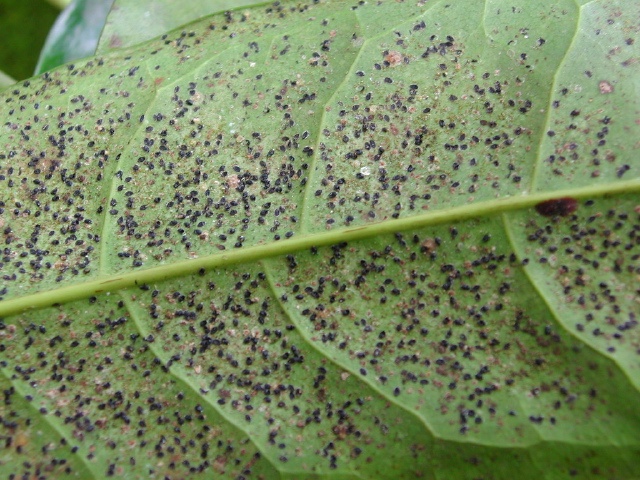 Gnetum gnemon or two leaf is a tree cabbage used throughout Solomon Islands and elsewhere. The attached photo was taken at Lata, Nendo Island, Temotu Province, where the tree is particularly popular and forms part of an improved farming system of 20 or more species of fruit and nut trees. It was dry up till Christmas when the scale became common causing premature leaf fall. What is it? Gnetum gnemon or two leaf is a tree cabbage used throughout Solomon Islands and elsewhere. The attached photo was taken at Lata, Nendo Island, Temotu Province, where the tree is particularly popular and forms part of an improved farming system of 20 or more species of fruit and nut trees. It was dry up till Christmas when the scale became common causing premature leaf fall. What is it?
The first thought of members was a Coccid, possibly Milviscutus (=Coccus) mangiferae (Green). This is known from Gnetum in Solomon Islands, where it is widespread. Another possibility is Eucalymnatus
tesselatus (Another widespread species), but from what I can see the scales do not have the characteristic tessellated pattern of this species. It would also appear that the scales are fairly heavily parasitised.
However, as was pointed out, at less than 1 mm long, the scales are far too small to be Milviscutus
mangiferae or Eucalymnatus tesselatus, and the colour is entirely wrong (both these scales are green/ yellow/ brown, not black, in life). This if the black colour is the normal colour of the insects, and not due to parasitism?
Then there was the suggestion that as they are very black they might be Parlatoria ziziphi – although this species is usually a bit over 1 mm long. If they are not this species, they might well be black whitefly pupae.
It then became obvious that this was not a scale but the organge spiny whitefly larvae and pupae!
The spiny orange whitefly, Aleurocanthus spiniferus, has a whitish fringe around the late instar larvae and/or pupa, which can be seen around individuals in the lower left section of the leaf. It is present in PNG, whereit was found on Barringtonia sp. and Hibiscus sp. during a survey of Bemisia tabaci biotype B whitefly (also known as B argentifolii) and its natural enemies in the South Pacific (see Paul De Barro et al., 1997). It is better known as a pest of Citrus.
It could be another whitefly species, Aleurocanthus woglumi, whichlooks very similar. these two species are difficult to distinguish in the field. This pest was also recorded from PNG, on citrus and Annona reticulate (?custard apple).
The pupae of Aleurocanthus species are covered with fine, erect black spines. And note that Aleurocanthus woglumi is actively spreading in countries around the Caribbean at the moment.
There are good biological control agents available against both A woglumi and A spiniferus, in use in East and South Africa. There are numerous species of Aleurocanthus, some of them still undescribed; quite a few of them are native to Indomalaysia, where Gnetum gnetum came from.
The photo shows a few individuals of the pink wax scale, Ceroplastus rubens, (the most prominent specimen is slightly above the centre along the leaf vein). It is a common pest throughout the Pacific.
|
